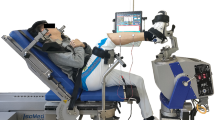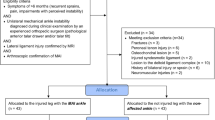Abstract
Purpose
Individuals with chronic ankle instability (CAI) have deficits in closed kinetic chain dorsiflexion that may perpetuate injury. Determining the characteristics of muscle stiffness in the plantar flexors of individuals with CAI may help in developing appropriate treatments. We aimed to highlight the characteristics of static muscle stiffness in ankle plantar flexor muscles during the passive dorsiflexion of the ankle joint in individuals with CAI.
Methods
A total of 30 patients were included in the study based on the International Ankle Consortium criteria. The patients were categorized evenly into healthy, coper, and CAI groups (i.e., 10 patients in each group). After measuring the dorsiflexion range of motion (non-weight-bearing/weight-bearing) of the ankle joint, the static muscle stiffness measurements of the medial gastrocnemius, lateral gastrocnemius, soleus, and peroneus longus were obtained. The measurements were performed during the knee joint's extension and 50° flexion and passive dorsiflexion between the range of 40° plantar flexion and 20° dorsiflexion.
Results
The dorsiflexion range of motion of the CAI group was significantly smaller than that of the healthy and coper groups in the weight-bearing position. No interaction was observed for muscle stiffness in both the knee flexion and extension positions, and no significant differences were identified among the three groups. The shear modulus of the soleus at 20° ankle dorsiflexion with knee flexion had a significant negative correlation with the weight-bearing range of motion of the ankle.
Conclusion
The limitation in the weight-bearing dorsiflexion range of motion in CAI was largely due to factors other than the increased elasticity of the ankle plantar flexor muscles.







Similar content being viewed by others
Data availability
Authors are prepared to release data upon request.
References
Hertel J, Corbett RO. An updated model of chronic ankle instability. J Athl Train. 2019;54:572–88.
Houston MN, Hoch JM, Hoch MC. Patient-reported outcome measures in individuals with chronic ankle instability: a systematic review. J Athl Train. 2015. https://doi.org/10.4085/1062-6050-50.9.01.
Martin RL, Davenport TE, Fraser JJ, et al. Ankle stability and movement coordination impairments: lateral ankle ligament sprains revision 2021. J Orthop Sports Phys Ther. 2021;51:CPG1–80.
Vuurberg G, Hoorntje A, Wink LM, et al. Diagnosis, treatment and prevention of ankle sprains: update of an evidence-based clinical guideline. Br J Sports Med. 2018;52:956.
Gabriner ML, Houston MN, Kirby JL, et al. Contributing factors to star excursion balance test performance in individuals with chronic ankle instability. Gait Posture. 2015;41:912–6.
Weerasekara I, Osmotherly P, Snodgrass S, et al. Clinical benefits of joint mobilization on ankle sprains: a systematic review and meta-analysis. Arch Phys Med Rehabil. 2018;99:1395-1412 e5.
Handoll HH, Rowe BH, Quinn KM, et al. Interventions for preventing ankle ligament injuries. Cochrane Database Syst Rev. 2001;3: CD000018.
Doherty C, Bleakley C, Delahunt E, et al. Treatment and prevention of acute and recurrent ankle sprain: an overview of systematic reviews with meta-analysis. Br J Sports Med. 2017;51:113–25.
Judson LJ, Churchill SM, Barnes A, et al. Joint moments and power in the acceleration phase of bend sprinting. J Biomech. 2020;101: 109632.
Weinhandl JT, Smith JD, Dugan EL. The effects of repetitive drop jumps on impact phase joint kinematics and kinetics. J Appl Biomech. 2011;27:108–15.
Maisetti O, Hug F, Bouillard K, et al. Characterization of passive elastic properties of the human medial gastrocnemius muscle belly using supersonic shear imaging. J Biomech. 2012;45:978–84.
Koo TK, Guo JY, Cohen JH, et al. Relationship between shear elastic modulus and passive muscle force: an ex-vivo study. J Biomech. 2013;46:2053–9.
Liu J, Qian Z, Wang K, et al. Non-invasive quantitative assessment of muscle force based on ultrasonic shear wave elastography. Ultrasound Med Biol. 2019;45:440–51.
Eby SF, Song P, Chen S, et al. Validation of shear wave elastography in skeletal muscle. J Biomech. 2013;46:2381–7.
Le Sant G, Nordez A, Hug F, et al. Effects of stroke injury on the shear modulus of the lower leg muscle during passive dorsiflexion. J Appl Physiol (1985). 2019;126:11–22.
Kobayashi T, Watanabe K, Ito T, et al. The Effect of novel ankle-realigning socks on dynamic postural stability in individuals with chronic ankle instability. Int J Sports Phys Ther. 2019;14:264–72.
Gribble PA, Delahunt E, Bleakley C, et al. Selection criteria for patients with chronic ankle instability in controlled research: a position statement of the International Ankle Consortium. Br J Sports Med. 2014;48:1014–8.
Hiller CE, Refshauge KM, Bundy AC, et al. The Cumberland ankle instability tool: a report of validity and reliability testing. Arch Phys Med Rehabil. 2006;87:1235–41.
Morse CI. Gender differences in the passive stiffness of the human gastrocnemius muscle during stretch. Eur J Appl Physiol. 2011;111:2149–54.
Bennell KL, Talbot RC, Wajswelner H, et al. Intra-rater and inter-rater reliability of a weight-bearing lunge measure of ankle dorsiflexion. Aust J Physiother. 1998;44:175–80.
Powden CJ, Hoch JM, Hoch MC. Reliability and minimal detectable change of the weight-bearing lunge test: a systematic review. Man Ther. 2015;20:524–32.
Le Sant G, Nordez A, Andrade R, et al. Stiffness mapping of lower leg muscles during passive dorsiflexion. J Anat. 2017;230:639–50.
Hermens HJ, Freriks B, Disselhorst-Klug C, et al. Development of recommendations for SEMG sensors and sensor placement procedures. J Electromyogr Kinesiol. 2000;10:361–74.
Hislop HJ, Avers D, Brown M. Daniels and Worthingham’s muscle testing: techniques of manual examination and performance testing. 10th ed. St. Louis: Elsevier; 2018.
Shiina T. JSUM ultrasound elastography practice guidelines: basics and terminology. J Med Ultrason. 2013;40:309–23.
Kodesho T, Taniguchi K, Kato T, et al. Intramuscular differences in shear modulus of the rectus femoris muscle during passive knee flexion. Eur J Appl Physiol. 2021;121:1441–9.
Freitas SR, Antunes A, Salmon P, et al. Does epimuscular myofascial force transmission occur between the human quadriceps muscles in vivo during passive stretching? J Biomech. 2019;83:91–6.
Hug F, Lacourpaille L, Maisetti O, et al. Slack length of gastrocnemius medialis and Achilles tendon occurs at different ankle angles. J Biomech. 2013;46:2534–8.
Koo TK, Guo JY, Cohen JH, et al. Quantifying the passive stretching response of human tibialis anterior muscle using shear wave elastography. Clin Biomech (Bristol, Avon). 2014;29:33–9.
Xu J, Hug F, Fu SN. Stiffness of individual quadriceps muscle assessed using ultrasound shear wave elastography during passive stretching. J Sport Health Sci. 2018;7:245–9.
Denegar CR, Hertel J, Fonseca J. The effect of lateral ankle sprain on dorsiflexion range of motion, posterior talar glide, and joint laxity. J Orthop Sports Phys Ther. 2002;32:166–73.
Tabrizi P, McIntyre WM, Quesnel MB, et al. Limited dorsiflexion predisposes to injuries of the ankle in children. J Bone Joint Surg Br. 2000;82:1103–6.
Terada M, Pietrosimone BG, Gribble PA. Therapeutic interventions for increasing ankle dorsiflexion after ankle sprain: a systematic review. J Athl Train. 2013;48:696–709.
Pope R, Herbert R, Kirwan J. Effects of ankle dorsiflexion range and pre-exercise calf muscle stretching on injury risk in Army recruits. Aust J Physiother. 1998;44:165–72.
Youdas JW, Krause DA, Egan KS, et al. The effect of static stretching of the calf muscle-tendon unit on active ankle dorsiflexion range of motion. J Orthop Sports Phys Ther. 2003;33:408–17.
Caputo AM, Lee JY, Spritzer CE, et al. In vivo kinematics of the tibiotalar joint after lateral ankle instability. Am J Sports Med. 2009;37:2241–8.
Kobayashi T, Saka M, Suzuki E, et al. In vivo kinematics of the talocrural and subtalar joints during weightbearing ankle rotation in chronic ankle instability. Foot Ankle Spec. 2014;7:13–9.
Kobayashi T, Suzuki E, Yamazaki N, et al. Fibular malalignment in individuals with chronic ankle instability. J Orthop Sports Phys Ther. 2014;44:872–8.
Powden CJ, Hoch JM, Hoch MC. Rehabilitation and improvement of health-related quality-of-life detriments in individuals with chronic ankle instability: a meta-analysis. J Athl Train. 2017;52:753–65.
Chino K, Takahashi H. Measurement of gastrocnemius muscle elasticity by shear wave elastography: association with passive ankle joint stiffness and sex differences. Eur J Appl Physiol. 2016;116:823–30.
Miyamoto N, Hirata K, Miyamoto-Mikami E, et al. Associations of passive muscle stiffness, muscle stretch tolerance, and muscle slack angle with range of motion: individual and sex differences. Sci Rep. 2018;8: 8274.
Saeki J, Ikezoe T, Yoshimi S, et al. Menstrual cycle variation and gender difference in muscle stiffness of triceps surae. Clin Biomech (Bristol, Avon). 2019;61:222–6.
Acknowledgements
The study was supported by the Japan Society for the Promotion of Science (Grant No. 19K19916).
Author information
Authors and Affiliations
Corresponding author
Ethics declarations
Conflict of interest
The authors have no conflicts of interest to declare.
Ethical statements
The study protocol was approved by the ethics committee of the author’s institution.
Additional information
Publisher's Note
Springer Nature remains neutral with regard to jurisdictional claims in published maps and institutional affiliations.
About this article
Cite this article
Kobayashi, T., Kodesho, T., Kinami, K. et al. Characteristics of the static muscle stiffness of ankle plantar flexors in individuals with chronic ankle instability. J Med Ultrasonics 50, 561–570 (2023). https://doi.org/10.1007/s10396-023-01360-5
Received:
Accepted:
Published:
Issue Date:
DOI: https://doi.org/10.1007/s10396-023-01360-5




